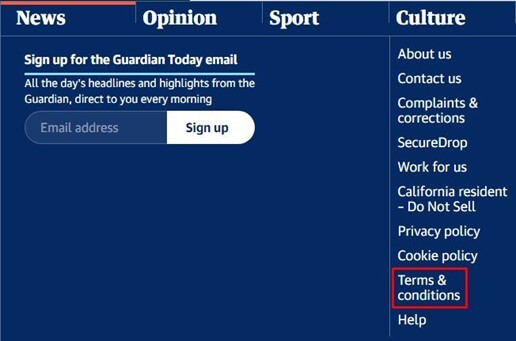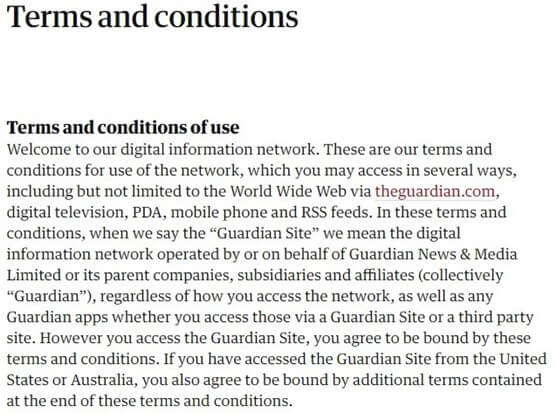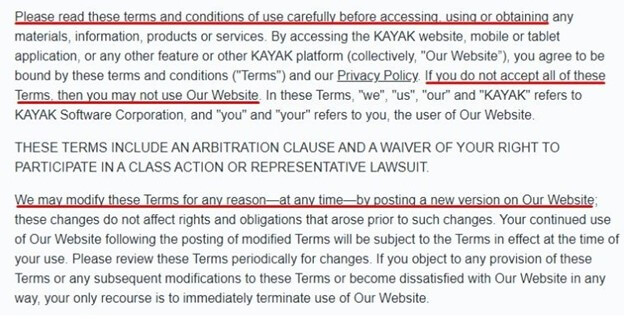Terms and Conditions: The Essential Guide
You have most likely come across terms and conditions pages one too many times on almost every website you visit. As your website is your company's internet front door, ensuring all the pegs fit into the holes properly is vital. The terms and conditions of your website, often known as "terms of use" or "terms of service," establish the ground rules for users who visit your website and serve as a binding agreement between you and the website visitor.

You have most likely come across terms and conditions pages one too many times on almost every website you visit. As your website is your company’s internet front door, ensuring all the pegs fit into the holes properly is vital.
The terms and conditions of your website, often known as “terms of use” or “terms of service,” establish the ground rules for users who visit your website and serve as a binding agreement between you and the website visitor. Should a dispute arise, the website’s terms and conditions protect you from legal liability.
This guide will walk you through the essentials and how to create good website terms and conditions.
What is a Terms and Conditions page?
Terms and conditions are the details that outline the ground rules of your website. They’re not required by law, but courts often consider them when interpreting what type of contract you have with a customer or business partner. Visitors are made aware of what is and isn’t allowed on your website by a clearly worded set of terms and conditions.
You must put a privacy policy on your website if you collect identifiable information from users, such as names, addresses, phone numbers, email addresses, or credit cards. Your website should also include a terms and conditions section. If you are collecting sensitive information like social security digits and birth dates, it’s worth considering consulting an attorney.
You can use a Terms & Conditions page to:
- Prevent abuse: You can add a Terms and Conditions page to your website to specify behaviors you do not condone, such as spamming other people on the website or submitting libelous content.
- Establish site content ownership: A Terms and Conditions page can inform your visitors that the content on your site is your property.
- Limit liability: Terms and Conditions pages can protect websites from lawsuits for misrepresenting or speculating, such as inaccuracies on the website.

Why You Need Terms and Conditions for your Website
Firms must abide by regulations that require specific information to be published online. This includes company details like company name, address, and domain registration information. All of this information is the best place for website terms and conditions.
There are five main justifications for having terms of service agreements that will keep you safe. The top five reasons businesses decide to draft terms of service for their websites are as follows:
Set conduct for your website.
You can specify what users are and are not permitted to do on your website in terms of usage. It will limit everything they can view and how they may use the material within these parameters.
Stay protected
Use warranty disclaimers to shield yourself from liability if something goes wrong on your website. No one would be able to hold you liable if something goes wrong as long as your website has a disclaimer warranty.
Set a judgment clause
You can avoid the potential of having a conflict with your users and end up in court. Your terms of service can describe how to settle these conflicts with you and other users.
Indemnify your website
To stay safe, ensure security measures will protect your website. You cannot always control what your users do on your website, no matter how much you try, but you will be able to defend against their actions if they violate the rights of others or the law.
Excuse yourself of liability
Your terms of service are a great way to protect your website from potential legal ramifications. It’s imperative to have the proper arrangements before unexpected trouble occurs.
How Do You Create Terms and Conditions?
When drafting your terms and conditions, keep them straightforward and easy to understand. If you steal terms and conditions from other sites, you get into legal trouble that could easily be avoided by creating your own tailored terms and conditions.
The terms and conditions on your website are there if someone attempts to read them. Make sure to do the following on your term and conditions page:
1. Define your site content
To successfully create Terms and Conditions, think about what is unique to your website. Ensure to include details related to your website to have a good Terms and Conditions document. You should check:
- What products or services your website provides
- Whether customers can purchase goods and services through your website.
- If your website has a minimum age requirement for users.
- If your website allows users to register.
- If your business offers subscription services or one-time purchases for its products or services (or both).
- What forms of payment your website accepts (if applicable.)
2. Be sure to add clauses
Indicate if there is any special information you want to include on your websites, such as clauses or requirements. Keep your wording simple and easy to understand so that you don’t introduce any ambiguities. It would help to create a new clause for each point you want to make and use keywords when necessary.
3. Guarantees inclusion
Your Terms and Conditions should include a guarantee depending on the nature of your website. A guarantee is a promise made by a firm or business to fulfill specific criteria, depending on the type of business.
4. Identify prohibited usage of your website
Consider setting boundaries for what visitors can do on your website. They might engage in any of the following:
- Harassing or mistreating other users
- Violating other users’ rights
- Violating copyright holders’ material on the site
- Compromising user accounts
You can also specify any other user behaviors you want to prohibit on your website.
5. Inform on third-party contributions
Identify businesses you are linking to on your website or advertising with. For instance, Amazon also adds outside businesses to their platform, allowing users to buy goods and services.
Items to Include in Your Terms and Conditions
The fundamental aspects of terms and conditions vary based on the type of business and how it runs. Consider the types of goods and services you offer, how you connect with consumers, any potential legal issues that may develop and how you plan to address them, how you intend to operate your website, and how customers can utilize it.
The responses can assist you in tailoring the basic website terms and conditions to your business requirements. In general, the terms and conditions include the following information:
- Privacy: If you have a privacy policy, it will be in this section of the terms and conditions. It will specify how your clients’ information is protected and any situations in which you may be unable to protect it. If a separate privacy policy applies to your website, you can link to that policy instead.
- Cookies: If your website uses cookies, you must include a section explaining their function and mention how users can turn them off in their browser settings.
- Acceptance of Terms: This section outlines the terms for accessing the site. Here, you can define whether or not you will permit children under a certain age to use the site.
- License to Use: This will explain that the visitor has a restricted right to access the website as long as they follow the terms outlined in the full terms of use.
- User Accounts: When users create an account, they confirm their genuine data and agree to be responsible for all account information, including the password.
- Acceptable Use Policy: This is where you inform that breaking the law, harvesting user data for money, sending inappropriate messages, and increasing their online presence are all reasons why someone could be banned from using this website.
- International Use and Compliance: This section provides information on how the website complies with local legislation.
- Termination and Modification: This section discusses how you can choose to terminate any visitor’s access at any time, without notice.
- Disclaimers: Make sure that you include all possible disclaimers/terms and conditions in this section. You should include, for instance, that the content is purely for informational reasons, that the site must be accepted in its current form, and that no liability will be undertaken for commitments not made.
Terms and Conditions Best Practices
If you want to succeed in the world of internet business, you need a professional and organized set of terms and conditions. These are some pointers for best practices.
- Create clear headings for your Terms and bold any significant elements.
- Use the same Terms across your quotations, invoices, and website.
- Make your terms fair and reasonable by placing yourself in your customers’ shoes.
Make sure a lawyer drafts and negotiates your contract when you receive assistance with terms and conditions. Here are a few more reasons why you should hire an attorney:
Understands contracts
Your attorney can read your contract and ensure it is appropriate for the situation. They can even negotiate the terms of the agreement.
Guarantees enforceability
By consulting an attorney for input on relevant contract agreements, you can make sure that your terms and conditions are enforceable.
Knows contract law
You might need to hire a contract attorney to ensure that your terms and conditions adhere to common contract laws as well as federal, state, and local regulations. There are online contracting attorneys available if you are unsure.
Prepared for a dispute
A contract lawyer can assist with renegotiating agreements or court disputes. They are current on a company’s legal history and current state of affairs.
Avoid making legal mistakes
Get legal advice by speaking with a lawyer. You can avoid potential issues if you stick to basic contract templates that can be found online. If you want complete peace of mind, contract templates are available with a certified professional.
Consumer Law mandates the website Terms and Conditions of Use; thus, they must exist and are appropriate to your company. Whether or not they are read, this is a legal necessity.
It is best to include a “click” button to “Accept” the site’s Terms to ensure that users are aware of their presence. Users will be led to the Terms if they want to view them.
The terms and conditions must be updated as soon as new items or services are offered. Changes could also affect how much customers are charged in fees. You must inform users of any modifications to the Terms and Conditions of Use if there is a change in the terms.
The Best Terms and Conditions Examples
1. The Guardian Terms and Conditions
The Guardian has placed an agreement at the bottom of each webpage, so you can easily access it.

Guardian’s Agreement is simple and follows the design of their website. But the agreement is lengthy and has varying clauses for the Guardian’s needs, such as Registration, Third party advertising on the Guardian Site, Disclaimer of liability, etc.
The Terms and Conditions contain a brief introduction that sets the tone for the rest of the content.

2. KAYAK Terms and Conditions
At the bottom, KAYAK also includes a link to its Terms & Conditions:

Users can easily understand KAYAK’s agreement’s first paragraph as follows:

3. Instagram Terms and Conditions
The Terms link for Instagram is located in the website’s footer:

The links to Instagram’s Policy and Terms of Service are displayed when a user creates an account.

4. Spotify Terms and Conditions
The table of contents below shows the topic of Spotify‘s terms and conditions.

The section of this legal agreement that discusses how users should use (or not use) your website and app is arguably the most significant.
Wrapping Up
It is imperative for every company to have a written agreement on its website, app, or service. If you do not have one, you risk taking on legal and financial risks. Your business also needs the protection of its assets. A written agreement can provide conditions for your services to be used and administered.

Download Kadence Theme & Kadence Blocks To Build An Effective Websites
If you love to create compelling content with beautiful design, Kadence Blocks provides tools to be creative right in the native WordPress editor. Plus, enjoy tons of prebuilt content you can easily include in your site, including a wireframe library of blocks to get your started on your next web design. Great for inspiration and fast development!
Sign up now — Get SolidWP updates and valuable content straight to your inbox
Sign up
Get started with confidence — risk free, guaranteed
